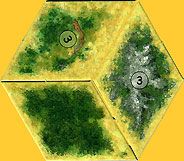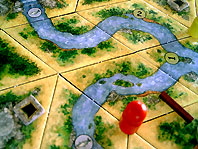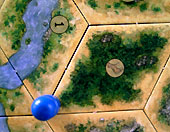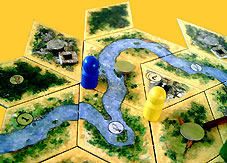Lost Valley
Authors: Roland & Tobias Goslar
Publisher: Kronberger Spiele
Year: 2004
review by

| x |
|
|
|
|
|
|
|
|
|
|
|
|
|
|
|
|
|
|
|
|
|
|
|
|
|
|
 |
|
Three to four adventurers set out to discover the Lost Valley. This quest is not in the first place inspired by scientific curiosity, but by gold fever. At first they are armed only with a backpack containing the bare necessities of life: food, timber, tools and whisky. All prospectors start at the trading post, where they can return at any time to spend the gold they discovered in the valley on equipment the real adventurer can’t do without, such as horses, carts, boats, fishing rods and rifles. In the beginning there is only a large tile displaying the trading post, which is situated on an island in the river. During the game the board is expanded with diamond-shaped tiles, the trademark of the Goslar brothers. The prospectors are only allowed to move along the edges of these tiles. |
| x |
|
|
|
|
|
|
|
|
|
|
|
|
|
|
|
|
|
|
|
|
|
|
|
|
|
|
| On the diamond-shaped tiles various types of terrain are shown, often also displaying a symbol. The different terrains are water, forest, mountains or tundra. On the forest tiles, timber can be obtained, on the tiles with an animal-symbol (river tiles, forest tiles or tundra tiles), food can be obtained, and furthermore there is lots of gold to be found. On many of the tiles a green or grey circle is shown, labelled with a number; this indicates how many green rivergold markers or grey mountaingold markers should be placed in this area. Rivergold markers are worth 1 or 2 nuggets (indicated on the back), and mountaingold markers are worth 3 or 4 nuggets. Gold is the most important aspect of the game. Not only is it used to buy suitable equipment at the trading post, it’s also required to win the game |
|
 |
| x |
|
|
|
|
|
|
|
|
|
|
|
|
|
|
|
|
|
|
|
|
|
|
|
|
|
|
 |
|
The gold is not exactly there for the taking. To mine rivergold, the presence of water is required; if the markers are already on a river tile the passing prospector can mine it at the cost of one food marker for each gold marker. If there is no water present, the tile where the gold is located must be connected to the river with a canal before mining is possible. Canals can be built using one timber per tile that needs to be crossed. Mountaingold is even harder to obtain, but in return the mountaingold markers are worth more nuggets than rivergold markers. First, a mine needs to be built, which costs a tool, a food and a timber. Then, the gold can be mined, at the cost of one food and one timber for each gold marker. |
| x |
|
|
|
|
|
|
|
|
|
|
|
|
|
|
|
|
|
|
|
|
|
|
|
|
|
|
| This all sounds rather straightforward, but it gets complicated by the fact that a player can only perform one action per turn, before or after moving their playing figure. And everything counts as an action: chopping wood, gathering food, mining gold, building a mine, constructing a canal et cetera. During a turn only very little can be accomplished, which is especially inconvenient because players are allowed to use mines or canals built by other players; there is no such thing as property right in this valley! The movement phase is also severely restricted: a player can only move along one edge of a land tile, or two edges if he remains along the river. |
|
 |
| x |
|
|
|
|
|
|
|
|
|
|
|
|
|
|
|
|
|
|
|
|
|
|
|
|
|
|
 |
|
The river cannot be crossed at will, but only via the fords located near the trading post. This means that there’s a lot of travelling around going on in order to explore the entire valley, because the river runs through the middle of the valley and on both sides of the river promising sites can be found. When during the movement phase a player reaches an intersection that is still unexplored, the movement ends and new land is explored. First, the river is lengthened by placing a river tile, and then land tiles are placed until the empty space is completely filled. |
| x |
|
|
|
|
|
|
|
|
|
|
|
|
|
|
|
|
|
|
 |
| x |
|
|
|
|
|
|
|
|
|
|
|
|
|
|
|
|
|
|
 |
|
|
|
|
|
|
|
|
|
|
|
|
|
|
 |
|
|
|
|
|
|
|
|
|
|
|
|
|
|
 |
|
|
|
|
|
|
|
|
|
|
|
|
|
|
| x |
|
|
|
|
|
|
|
|
|
|
|
|
|
|
|
|
|
|
 |
|
|
|
|
|
|
|
|
 |
|
|
|
|
|
|
|
|
|
|